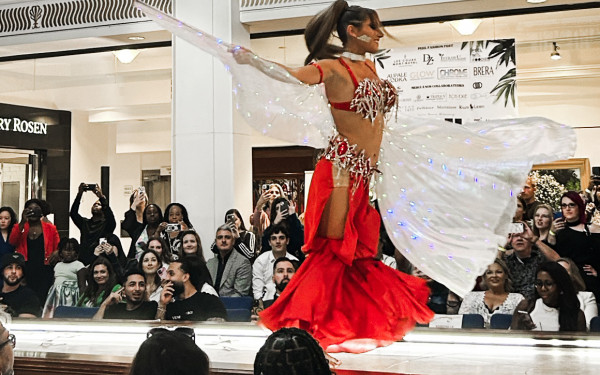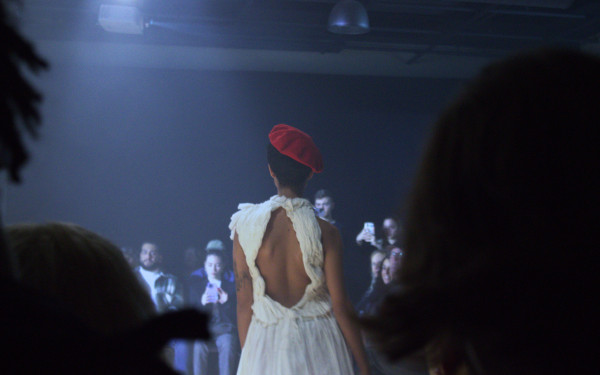Montreal Fashion Week
The Violent and the Sustainable
In the hopes of showcasing early spring trends, local socialites and fashionistas peeped out into the cold and endured the icy cobblestones to reunite for Montreal’s 22nd semiannual Fashion Week. Though the Bonsecours Market was filled with guests in floral and spring’s vibrant colours, the catwalk unveiled the fall/winter 2012 trends of fur, wool and leather.
This year, Montreal Fashion Week incorporated 28 local and national designers with collections varying in materials. The Link interviewed two designers with quite contrasting collections, choice of fabrics and designs; while one represents the era of eco-friendly clothing, the other embodies the duality of S&M.
Abol
As a new addition to Montreal Fashion Week, Abol’s eco friendly haute-couture collection was a breath of fresh air. With a creative soul and love for nature, Hamideh Abol evolved from an engineer to an inspirational designer. Her recent collection is a compilation of one-of-a-kind-pieces made from raw organic wool and reclaimed silk.
Through the unique and time-consuming technique of transforming raw wool into felt, Abol’s goal is to translate ideas and images in paintings and sculptures into unique wearable art.
“I’m creating a collection where each piece has an identity, defining a certain character to existence out of something that’s in [my mind],” says Abol. “That’s surrealism.”
With no evident common flow of colour or cut throughout the collection, each piece is a story in-itself. Dressed in felted wool and frizzy beehive up-dos, the models emit an air of animal royalty. While Abol’s artistic inspiration is seen through her cuts and 3-D felted wool designs, her love for nature comes out through the rich neutrals.
The Iranian born Abol was exposed to her mother’s Persian culture of rug weaving. She fell in love with this particular technique of felting and instantly felt the need to introduce it to the fashion world. Using only Canadian resources, Abol visits local farms in search of raw wool. Though local materials may cost more than imported fabrics, Abol refuses to resort to cheap material.
“We have the best wool in the world, the best farms with healthy animals” say Abol, “but we don’t use what we have.”
When she can, Abol visits the farms herself to examine the sheep and ensures the method is safe and animal friendly. Though her pieces may cost more than most people would prefer to spend, Abol hopes customers will value the uniqueness and handmade quality of her pieces.
“My main challenge is being appreciated for the work I’m doing and finding customers that would appreciate it for the price that I’m offering,” says Abol.
Anastasia Lomonova
Ukrainian-born designer Anastasia Lomonova is one of Canada’s up and coming designers. Winner of the 2010 Toronto Fashion Incubator New Label competition, Lomonova has been thriving ever since.
Inspired by the pain and pleasure duality of S&M, Lomonova’s new collection is combination of structured and flaccid draping, and a fusion of leather and chiffon, a recurring fabric in her collections. Limiting herself to the basic colours of black, blue and grey, Lomonova was able to further concentrate on the cuts, textures and shapes of the clothes.
“There’s a sense of discipline at times where the pleats are placed very carefully,” says Lomonova, “and then there’s no discipline at all in the other places where they’re just casually draped.”
Painted with black eye makeup and lipstick with tightly slicked back hair, the models strutted down the runway with an air of violence and sexuality. The collection transitioned from very strict bond-like dresses to pieces with a softer element of sensuality. Through the softness of the pleated chiffon and the rawness of leathered graphic lines, Lomonova’s collection is a perfect balance between passivity and strength.
“It’s the idea of a pure discipline, matched with pleasure that derives from that, and pain that corresponds with it,” says Lomonova. “[This is] a theme that’s seen through S&M.”
Though the collection was very dark and somber, Lomonova ended her show with a bright ray of pure white. For the first time, the young designer included a wedding dress. Lomonova admits she was tired of seeing modern women restricted to the standard formula cupcake-looking gowns. The dress is Lomonova’s interpretation of a wedding dress and an extension of her collection.
“It’s not something that overtakes the bride,” says the designer, “it’s something that enhances her.”

568647_700_1057_90.jpg)
4web_700_1057_90.jpg)
6.WebEdit_700_1057_90.jpg)
_600_832_s.png)




